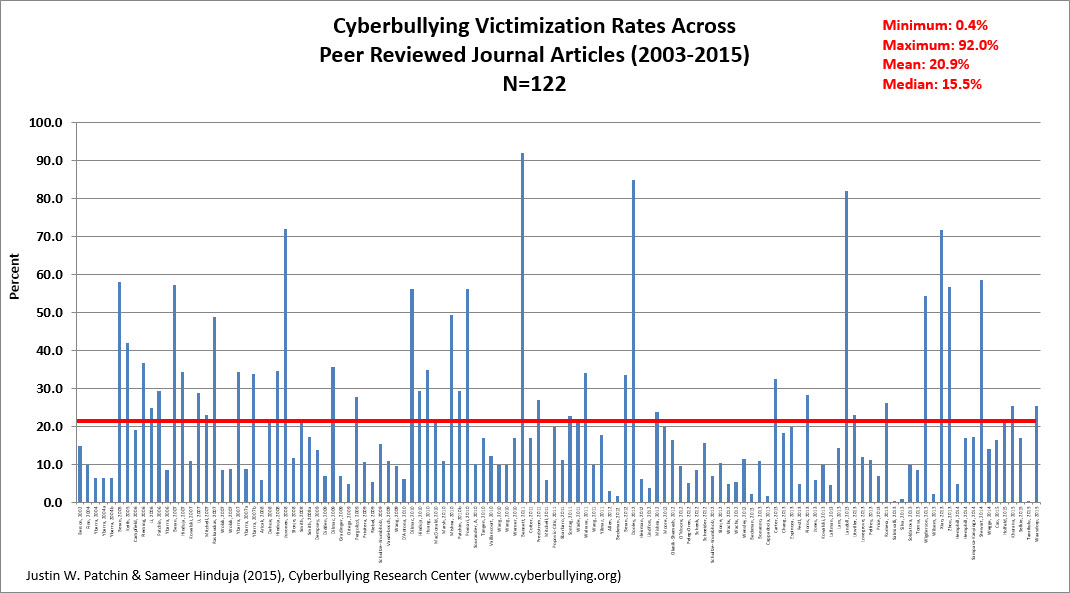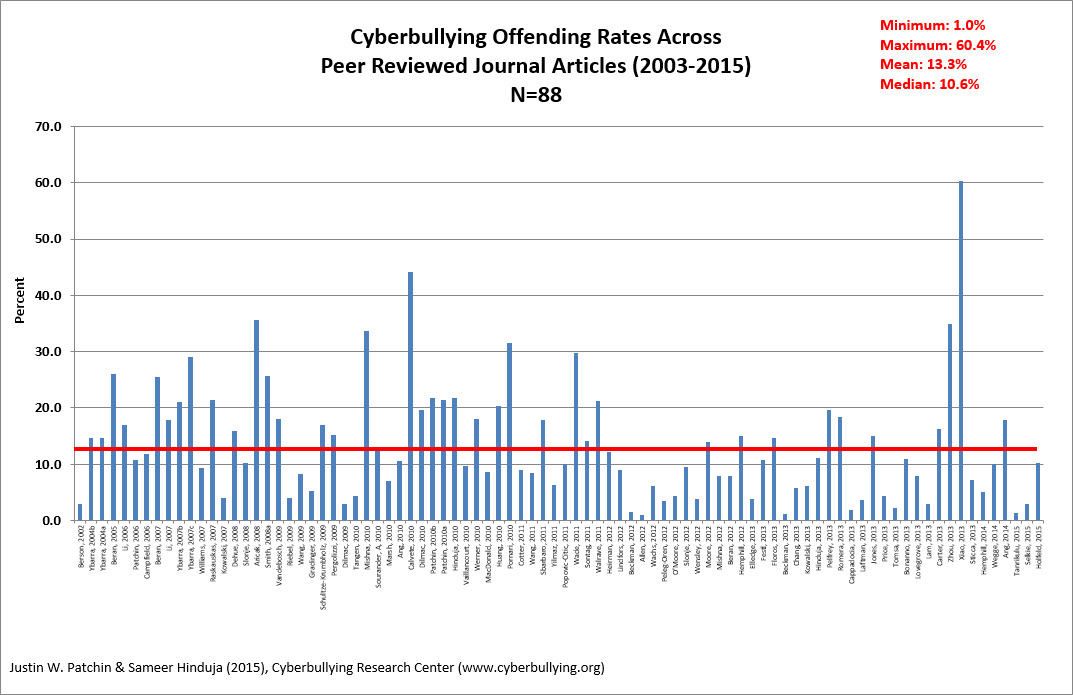Who is Ethically Responsible for the Rise and Continuance of Cyberbullying
Cyberbullying Facts: Summarizing What is Currently Known
Since 2002, we have surveyed over 25,000 elementary, middle, and high school students in fourteen different studies throughout the United States. The first two studies were online exploratory samples used to obtain a general understanding of the problem. As such, the numbers obtained are higher than average and not representative because they only include online teens who volunteered to participate. Our twelve most recent studies, however, have all been random samples of known populations, so we can be fairly confident in the reliability and validity of the data obtained (click here for more information about the methodology). Overall, about 27% of the teens we have surveyed over the last eleven studies have told us that they have been cyberbullied at some point in their lifetimes. About 10% said they were cyberbullied in the 30 days preceding the survey. Similarly, about 16% of those who we surveyed admitted that they had cyberbullied others at some point in their lifetimes (about 6% in the most recent 30 days). In 2020 we surveyed 1,034 tweens (9-12 year-olds) across the United States and found that about 15% of them had been cyberbullied at some point in their lifetimes (about 3% had cyberbullied others). More detailed information about our various studies involving teens (12- to 17-year-olds) can be found here. Our recent study findings involving tweens (9- to 12-year-olds) can be found here.
Cyberbullying Facts: Other Published Research
In 2015 we reviewed all of the published research we could find that included prevalence rates for cyberbullying. This work built on our earlier effort to quantitatively summarize published cyberbullying articles which we wrote about in our book Cyberbullying Prevention and Response: Expert Perspectives (see especially chapter 2). In total, we have now reviewed 234 articles published in peer-reviewed academic journals. One hundred and twenty-two of those included cyberbullying victimization rates and 88 included cyberbullying offending rates. As you can see from the charts below (click to enlarge), rates across all of the studies ranged widely, from 0.4% to 92% for victimization and from 1.0% to 60.4% for offending. The average across all of these studies was remarkably similar to the rates that we found in our work (about 21% of teens have been cyberbullied and about 13% admitted to cyberbullying others at some point in their lifetimes). Taken as a whole, it seems safe to conclude that about one out of every four teens has experienced cyberbullying, and about one out of every six teens has done it to others.


Cyberbullying Facts: Generalizations
A couple of other broad generalizations can be made about cyberbullying, based on recent research:
– Adolescent girls are just as likely, if not more likely than boys to experience cyberbullying (as a victim and offender) (Floros et al., 2013; Kowalski et al., 2008; Hinduja & Patchin, 2009; Schneider et al., 2012)
– Cyberbullying is related to low self-esteem, suicidal ideation, anger, frustration, and a variety of other emotional and psychological problems (Brighi et al., 2012; Hinduja & Patchin, 2010; Hinduja & Patchin, 2019; Kowalski & Limber, 2013; Patchin & Hinduja, 2010; Wang, Nansel, & Iannotti, 2011)
– Cyberbullying is related to other issues in the 'real world' including school problems, anti-social behavior, substance use, and delinquency (Hinduja & Patchin, 2007; Hinduja & Patchin, 2008; Kowalski & Limber, 2013)
– Traditional bullying is still more common than cyberbullying (Lenhart, 2007; Smith et al., 2008; Wang, Nansel, & Iannotti, 2011)
– Traditional bullying and cyberbullying are closely related: those who are bullied at school are bullied online and those who bully at school bully online (Hinduja & Patchin, 2009; Kowalski & Limber, 2013; Ybarra, Diener-West, & Leaf, 2007).
Cyberbullying Facts: Trends
There are only three studies that we are aware of that have explored cyberbullying experiences of students across the United States over time. The first analysis have been conducted by our friends at the Crimes Against Children Research Center at the University of New Hampshire. Examining the three waves of the Youth Internet Safety Survey (2000, 2005, 2010), they find a slight increase in cyberbullying behaviors over that time period (from 6% to 9% to 11%).
More recently, the Centers for Disease Control and Prevention conduct their biennial survey of students across the U.S. in their Youth Risk Behavior Surveillance System (YRBSS). This survey has long asked about bullying at school but in 2011 they added a question about "electronic" bullying. In 2019 (the most recent year available), 15.7% of students reported that they were bullied electronically, compared to 14.9% in 2017, 15.5% in 2015, 14.8% in 2013, and 16.2% in 2011.
Finally, the School Crime Supplement (SCS) of the National Crime Victimization Survey (NCVS) also surveys students every other year about victimization at school (and online bullying). This source observed a slight increase from 2009 to 2011 (from 6.2% to 9%), but the rate also decreased to 6.7% in 2013. In 2015, 2017, and 2019 (the most recent data available), researchers changed the way they measured cyberbullying–asked as a subset of bullying–which means the numbers cannot be directly compared to previous years. In 2019 16.5% of the 22.2% of students who were bullied said they had been bullied "online or by text."
Our research has shown a steady increase over time, but again it is problematic to directly compare our studies for a variety of reasons. One thing is for certain: cyberbullying is impacting a number of middle and high school students each year, and more can be done to prevent that.
Cyberbullying Prevalence Rates Over Time
| Patchin & Hinduja (previous 30 days) | Crimes Against Children Research Center | Youth Risk Behavior Surveillance System | NCVS School Crime Supplement | |
| 2000 | 6.0% | |||
| 2001 | ||||
| 2002 | ||||
| 2003 | ||||
| 2004 | 30.5% | |||
| 2005 | 9.0% | |||
| 2006 | ||||
| 2007 | 10.4% | |||
| 2008 | ||||
| 2009 | 8.3%; 7.0% | 6.2% | ||
| 2010 | 8.7%; 7.5% | 11.0% | ||
| 2011 | 7.3% | 16.2% | 9.0% | |
| 2012 | ||||
| 2013 | 8.1% | 14.8% | 6.7% | |
| 2014 | 12.2% | |||
| 2015 | 15.0% | 15.5% | 11.5%* | |
| 2016 | 16.5% | |||
| 2017 | 14.9% | 15.3%* | ||
| 2018 | ||||
| 2019 | 17.4% | 15.7% | 16.5%* | |
| 2020 | ||||
| 2021 | 23.2% |
So it is difficult from just looking at these few studies to determine if rates of cyberbullying is increasing or decreasing. Every study defines and measures cyberbullying differently and uses different response windows (we ask about experiences in their lifetime and last 30 days while the NCVS asks about what happened in the last year). We need to collect additional data points over time using consistent measures.
Cyberbullying Facts: References
Brighi, A., Melotti, G., Guarini, A., Genta, M. L., Ortega, R., Mora-Merchán, J., Smith, P. K. and Thompson, F. (2012). Self-Esteem and Loneliness in Relation to Cyberbullying in Three European Countries, in Cyberbullying in the Global Playground: Research from International Perspectives (eds Q. Li, D. Cross and P. K. Smith), Wiley-Blackwell, Oxford, UK.
Floros, G.D., Simos, K. E., Fisoun, V., Dafouli, E., and Geroukalis, D. (2013). Adolescent online cyberbullying in Greece: The impact of parental online security practices, bonding, and online impulsiveness. Journal of School Health, 83(6), 445-453.
Hinduja, S. & Patchin, J. W. (2007). Offline consequences of online victimization: School violence and delinquency. Journal of School Violence, 6(3), 89-112.
Hinduja, S. & Patchin, J. W. (2008). Cyberbullying: An exploratory analysis of factors related to offending and victimization. Deviant Behavior, 29(2), 129-156.
Hinduja, S. & Patchin, J. W. (2009). Bullying beyond the Schoolyard: Preventing and Responding to Cyberbullying. Thousand Oaks, CA: Sage Publications.
Hinduja, S. & Patchin, J. W. (2010). Bullying, cyberbullying, and suicide. Archives of Suicide Research, 14(3), 206-221.
Hinduja, S. & Patchin, J. W. (2012). Cyberbullying: Neither an Epidemic Nor a Rarity. European Journal of Developmental Psychology, 9(5), 539-543.
Hinduja, S. & Patchin, J. W. (2019). Connecting Adolescent Suicide to the Severity of Bullying and Cyberbullying. Journal of School Violence, 18(3), 333-346.
Kowalski, R. M. & Limber, S. P. (2013). Psychological, Physical, and Academic Correlates of Cyberbullying and Traditional Bullying. Journal of Adolescent Health, 53(1), S13-S20.
Kowalski, R. M., Limber, S. P. & Agatston, P.W. (2008). Cyber Bullying: Bullying in the Digital Age. Malden, MA: Wiley-Blackwell.
Lenhart, A. (2007). Cyberbullying and Online Teens. Pew Internet & American Life Project, June
27. (http://www.pewinternet.org/PPF/r/216/report_display.asp).
Patchin, J. W. & Hinduja, S. (2010). Cyberbullying and self-esteem. Journal of School Health, 80(12), 614-621.
Patchin, J. W. & Hinduja, S. (2013). Cyberbullying among Adolescents: Implications for Empirical Research. Journal of Adolescent Health 53(4), 431-432.
Schneider, S.K., O'Donnell, L, Stueve, A., and Coulter, R.W.S. (2012). Cyberbullying, school bullying, and psychological distress: A regional census of high school students. American Journal of Public Health, 102(1), 171-177.
Smith, P. K., Mahdavi, J., Carvalho, M., Fisher, S., Russell, S., and Tippett, N. (2008). Cyberbullying: its nature and impact in secondary school pupils. Journal of Child Psychology and Psychiatry 49(4): 376–385.
Wang, J., Nansel, T. R., & Iannotti, R. J. (2011). Cyber Bullying and Traditional Bullying: Differential Association with Depression. Journal of Adolescent Health, 48(4): 415–417.
Ybarra, M., Diener-West, M., & Leaf, P. J. (2007). Examining the Overlap in Internet Harassment and School Bullying: Implications for School Intervention. Journal of Adolescent Health, 41: S42–S50.
Ybarra, M. L., Espelage, D. L., & Mitchell, K. J. (2007). The Co-occurrence of Internet Harassment and Unwanted Sexual Solicitation Victimization and Perpetration: Associations with Psychosocial Indicators, Journal of Adolescent Health, 41, S31-S41.
Source: https://cyberbullying.org/facts
0 Response to "Who is Ethically Responsible for the Rise and Continuance of Cyberbullying"
Post a Comment